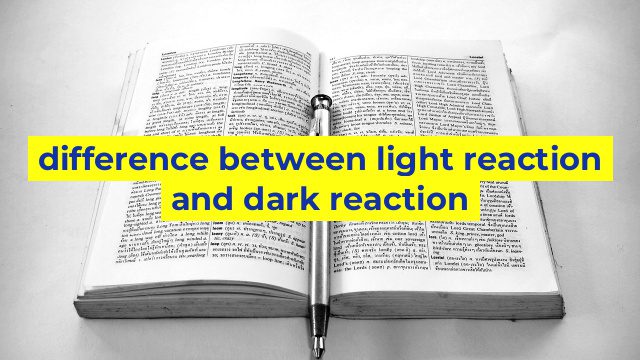Understanding the Difference Between Light Reaction and Dark Reaction in Photosynthesis
Photosynthesis is the process by which plants produce their own food by converting light energy into chemical energy. The process involves two main reactions: the light reaction and the dark reaction. These two reactions occur in different parts of the chloroplasts and have different roles in the process of photosynthesis.
The Light Reaction
The light reaction takes place in the thylakoid membrane of the chloroplasts. It is the first stage in photosynthesis and it requires light energy to occur. During this process, light energy is absorbed by the chlorophyll pigments present in the thylakoid membrane. This light energy is then converted into chemical energy in the form of ATP and NADPH. These two energy-rich molecules are important for the next stage of photosynthesis, the dark reaction.
The Dark Reaction
The dark reaction, also known as the Calvin cycle, occurs in the stroma of the chloroplasts. It is called the dark reaction because it does not directly require light energy, although it does require the products of the light reaction (ATP and NADPH). The dark reaction is responsible for converting carbon dioxide into glucose (sugar), which is the primary product of photosynthesis.
During the dark reaction, carbon dioxide is broken down into three-carbon molecules, which are then used to create glucose. The process also involves the enzymes RuBisCO and phosphoglyceraldehyde (PGA), which help to catalyze the reaction. Overall, the dark reaction is a vital part of photosynthesis as it provides the plant with the energy-rich molecules needed for growth and survival.
The Importance of Light and Dark Reactions in Photosynthesis
Both the light and dark reactions are important stages in the process of photosynthesis. The light reaction provides the energy needed to power the dark reaction, while the dark reaction converts carbon dioxide into glucose, which is necessary for the plant’s growth and survival. Without photosynthesis, plants would not be able to produce their own food and the entire food chain would be affected.
In conclusion, the difference between light reaction and dark reaction in photosynthesis lies in where they occur and what their roles are. The light reaction occurs in the thylakoid membrane and converts light energy into ATP and NADPH, while the dark reaction occurs in the stroma and converts carbon dioxide into glucose. These two reactions work together to produce the energy and food needed for plant growth and survival.
Table difference between light reaction and dark reaction
| Light Reaction | Dark Reaction |
|---|---|
| Occurs in the presence of light | Occurs in the absence of light |
| Converts light energy into chemical energy | Uses chemical energy to convert carbon dioxide into glucose |
| Occurs in the thylakoid membranes of chloroplasts | Occurs in the stroma of chloroplasts |
| Produces ATP and NADPH | Uses ATP and NADPH to power the production of glucose |
| Generates oxygen as a byproduct | Does not generate oxygen as a byproduct |
